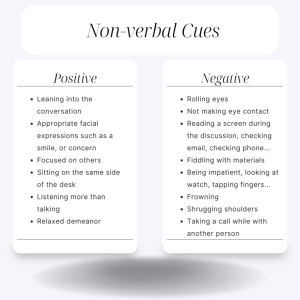Have you ever experienced communicating with someone when their words did not match what you saw and heard? How did that make you feel? Did it engender a feeling of trust, of valuing and respecting you, of being forthright with you? Did you feel that something was amiss, inconsistent, or just plain wrong?
Communication is comprised of the words we use, our tone of voice, and our body language. Too often, we focus on choosing the right words to say but neglect the other aspects. “Non-verbals” are an extremely important part of communicating, and can be a powerful and effective tool for leaders, or highly problematic. Here are some examples:

Although there are many more non-verbal cues, however, you can likely see the difference between the actions on both sides of the communication spectrum. A common view is that communication is comprised of:
- 7% : what you say.
- 55% : intonation, or how you say it.
- 38% : non-verbal (body language).
Clearly, non-verbal communication is very powerful!
Also very powerful is the tone of the message. This combination of how we speak and how we act when we speak sends strong messages and must be in line with what we say, the actual words that we speak. Note the bold words below and how they change the meaning of the sentence.
- I DID NOT run over my mailbox
(maybe someone else ran over my mailbox)
- I did not RUN OVER my mailbox
(maybe the mailbox got damaged some other way)
- I did not run over MY mailbox
(maybe I ran over someone else’s mailbox)
- I did not run over my MAILBOX
(maybe I ran over my child’s bike, instead)
Intonation can significantly change the meaning of the message – just as non-verbal cues can affect how the message is received.
The moral of this story is you must be aware of all of the factors that impact the delivery of a message. It’s also important to watch these factors that are coming from the person you are communicating with to determine how the message is being received.
As a leader, clear communication is critical in order to inspire your team and to be clear on the direction you need them to take in order to accomplish the results you all are trying to achieve.
Thanks to the good folks at HPISolutions for this article.

